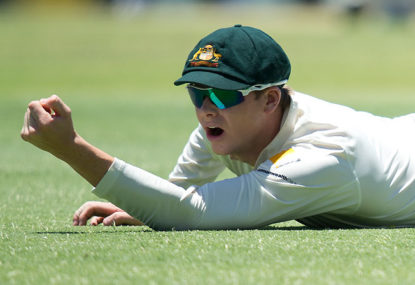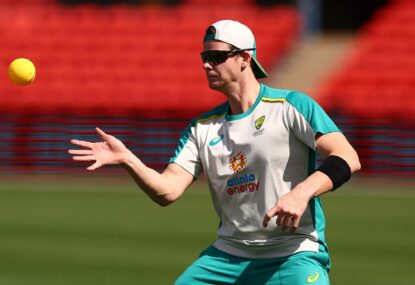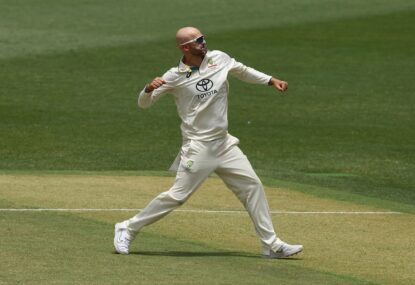When Steve Smith tosses his first coin at the Gabba as Australia’s 45th baggy green captain, it will be the biggest day of his life.
As it was for Ian Craig in 1957 against South Africa at Johannesburg, and Kim Hughes in 1979 against Pakistan at the WACA – the three youngest to achieve the highest recognition in the nation, after the prime minister.
Craig was 22 years and 194 days when he first led Australia – cap number 165. Hughes was 24 years, 83 days at his first tilt as Australia’s Test captain – cap number 281.
And Smith will be 25 years, 197 days when he tosses against India, as cap number 415.
And how did they get there?
Craig, at 16 years and 249 days for NSW, was the youngest debutant in the history of the Sheffield Shield. At 17 years and 207 days he became the youngest batsman in the history of the game to score a first-class double century, a sweetly timed and unbeaten 213 against South Africa at the SCG.
Not even Don Bradman had played a first-class dig at that tender age, leaving pundits to describe Craig as another Bradman, a sure “kiss of death” prediction.
At 17 years and 239 days, Craig became Australia’s youngest Test cricketer, scoring 53 and 47 against South Africa at the MCG in 1953, but South Africa won by six wickets.
Craig missed over a season due to national service and working overseas for pharmaceutical company Boots, with the board’s permission, where he eventually ended up as managing director.
But at 21 years and 126 days he took over the NSW captaincy from the retired Keith Miller, and led the Blues to Sheffield Shield success while scoring 521 runs at 47.36, with two tons.
And at 22 years and 194 days, Ian Craig captained Australian for the first time against South Africa in South Africa, with Neil Harvey his vice-captain.
The Australian team was ranked the worst to leave these shores but won the series 3-0, despite legendary fast bowler Ray Lindwall being left out of the side.
In early 1958, Craig was seriously ill with hepatitis, and once he returned to cricket he was but a shadow of his former self, and Richie Benaud took over the captaincy of both NSW and Australia.
Having started so early, Ian Craig retired from first class cricket at 26, but still played for Mosman, where he was my first grade captain.
It was both a pleasure and a privilege to play under him, and like everyone else in that side, we learned a lot just watching him lead, and bat.
Just as importantly, Ian Craig was a damn good bloke, who died of cancer in Bowral last month aged 79.
Kim Hughes has been harshly treated by cricket historians, just looking at his captaincy stats of 28 Tests, with only seven at home, and just four wins overall.
As a kid in country Western Australia, he had all the potential to be a world-beater. He was so good as an early teenager, he regularly held his own with the men.
And he excelled at cricket, hockey, tennis and Aussie Rules. He was a natural.
Moving to Perth in his final year as a junior, Hughes scored 556 at 46, and took 28 wickets at six.
In 1970, aged 16, he played for Western Australia’s Under-19s, described by Ric Charlesworth as “the most gifted junior cricketer I ever saw – no-one else comes close”.
But he didn’t live up to his obvious potential, trying out for South Australia, and when that didn’t work he went home to Perth.
He had to wait until 1975 for his first-class debut, which he celebrated with a superb 119 against NSW at the WACA, and cracked another ton against Clive Lloyd’s West Indian side.
After carrying drinks in 1976 for Australia, Hughes made the history-making 1977 England tour, where Kerry Packer’s World Series Cricket broke.
His teammates didn’t want Hughes in WSC, so he missed out with Geoff Dymock, Craig Sergeant and Gary Cosier.
When peace was restored, and Hughes was still captain, many of the returning WSC cricketers gave Hughes an unfairly hard time.
Nobody will ever forget his emotion-charged and tearful resignation as Australian captain at the Gabba against the West Indies in 1984.
A reluctant Allan Border took over for the final two Tests of that series, on his way to a then world record 93 Tests as Australian captain, until South African Graeme Smith broke that record with 109, set this year.
But I suggest Roarers recall four of Kim Hughes’ nine Test tons that were majestic, and emphatic.
His first of 129 against England at the Gabba in 1978. His 130* against the Windies at the Gabba in 1979. His career-high 213 against India in Adelaide in 1981, and his 137 against England at the SCG in 1983.
Those were the real Kim Hughes digs, and why he deserves more credit under difficult circumstances.
Everyone knows Steve Smith, he’s only been around for just ‘five minutes’, and he’s made every one of those minutes count. This calendar year he’s come of age with 779 Test runs at 77.9.
That includes three tons – 115, 100, and a career-high 162* – and throw in a 97, 84, 55, and 52*, and he’s second only to David Warner’s runs scored of 1061 at 75.78.
Smith has already captained NSW to win the Sheffield Shield final last season, contributing 75 and 103*.
And he’s led the Sydney Sixes to Big Bash honours as well.
The knockers will say that’s not the same as captaining Test cricket, but they’d be wrong.
Captaincy is all about cricket nous, and having communication skills. Steve Smith has bucket-loads of both, and he’ll make a fine skipper.
The only query is where will the new skipper bat himself – at three, four or in his accustomed five?
For the team’s sake three would be ideal, dropping Shane Watson to four, and slotting in Michael Clarke’s replacement Shaun Marsh at five, with younger brother Mitchell Marsh at six and Brad Haddin at seven.
Whatever Steve Smith decides will be in the best interests of the team. He’s that sort of a bloke.






































































































